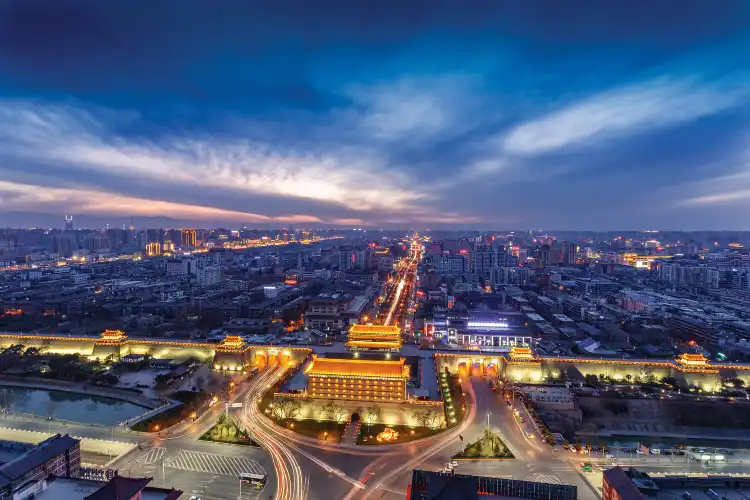
Best Hotels in Xi'an, China – Compare Prices, Reviews & Book Online
✓ 300M+ traveller trusted Trip.com ✓ 1.8M+ daily users ✓ 147M+ verified reviews ✓ 24/7 support in 30 seconds
Swipe down to view more
Filter by:
Hotel Star Rating
≤2345
Guest Rating
9+8+7+6+Popular Filters for Xi'an
Xi'an Bell TowerBreakfast includedHotelGreat 9+Free cancellationNon-smoking rooms2 bedsWithin 1 kmWithin 2 yearsPoolProperty Type
HotelServiced apartmentResortVilla hotelApartmentChinese innGuest houseVillaUnique StaysFarm stayCountry houseHomestayHostelInnCapsule hotelProperty facilities & services
PoolLaundry roomCurrency exchangeGymSpaLuggage storageSaunaParking availableElevatorFree parkingWi-Fi in public areasSmoking areaPets welcomeRestaurantWater parkCar rentalsEV charging stationBarBarbecueGolf courseWake-up callConference roomairport transfersFree airport transfersFind Best Xi'an Hotels - 2916 Options with Great Prices & Reviews
Explore a curated selection of premier accommodations and compare top rated hotels in Xi'an to find the perfect match for your travel style and budget. Book with confidence, backed by verified guest reviews.
Most Booked
Lowest price
Closest to downtown
Highest Rated
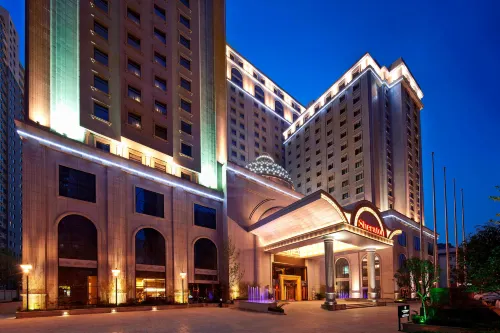
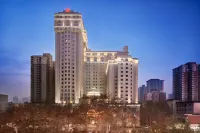


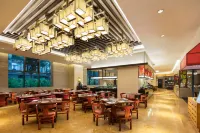


99+
Hotel near Beiguan/Longshou District,Xi'an
 No. 19 of Premium Hotels in Xi'an
No. 19 of Premium Hotels in Xi'anIndoor swimming pool
Massage room
Executive lounge
+17
"The location is incredibly convenient. Right across the street, there's a paid shuttle bus to the Terracotta Warriors, and the subway station is next to the hotel, making it easy to get to many attractions. There's also a large shopping mall directly opposite with plenty of dining options. Overall, the service was quite good. The only downside was the in-room facilities. When we visited, there was a significant drop in temperature, and the room's thermostat wasn't easy to adjust, so it got a bit hot at night. Another area for improvement is that when I checked in, I mentioned to the male front desk staff that a family member would be celebrating their birthday during our stay and I wanted to arrange a surprise. He said the manager would call me back later, but I never received that call. However, this didn't significantly impact our overall trip, and I would still recommend staying here."
Excellent
12756 reviews
9.6/10
1 night
From JPY 8,199
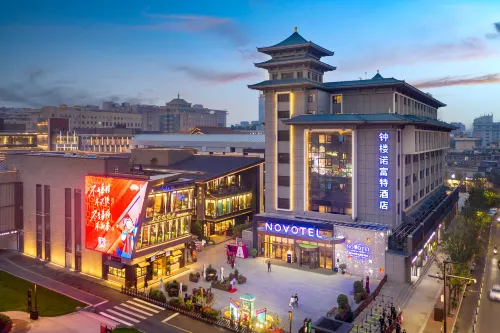






99+
Hotel near The bell tower The drum tower/The Xi’an Circumvallation,Xi'an
Hiking
Gym
Public parking
+22
"I was recommended by my friend to stay at Novotel Bell Tower. At the Level 2 check in counter we were greeted warmly by Ms. Sharon He Yun (何云). Check in was seamless and service was 5 stars. Sharon offered warm milk to be delivered to our rooms before we turned in and guided us on some good eateries. Definitely helpful in a cold, night winter night as first-timer to Xi'an.
The other staff worth mentioning is Ms. Jennifer Guo. She was kind and helpful to young guests and treated my teenage girl with respect and assistance as would any adult guests.
Room condition was superb, clean and cosy. Amenities were sufficient. Things you ordered get delivered by robot! Toilet seats has warming function and remote flushing. Location is great, near to lots of eateries and a stone throw away to Hui Min Street (回民街)。 Take a walk to Luo Ma Shi (骡马市)too. Novotel is 45 min away by car to the Teraotta. If you book the local tour remember that the performance is not included in the package. It'll cost about RMB350 extra to watch, but hey, you came all the way here and it was worth it.
Overall experience starting from the great staff in Novotel will definitely bring us back to Xi'an and this hotel again."
Outstanding
9355 reviews
9.5/10
1 night
From JPY 7,101
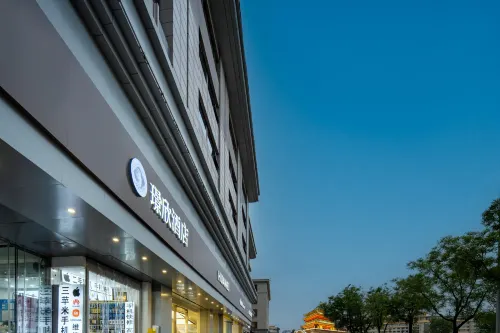

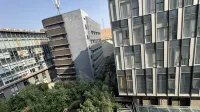




99+
Hotel near The bell tower The drum tower/The Xi’an Circumvallation,Xi'an
 No. 15 of 4-Star Select Hotels in Shaanxi
No. 15 of 4-Star Select Hotels in ShaanxiSunbathing area
Hiking
Gym
+23
"Highly recommended for Xi’an. Great location. Tourist attraction; Bell tower, drum tower, muslim street by foot.
The shuttle bus to Terracotta Army also easy to access, just some metres away from hotel entrance.
One thing disturbing on the first night, there was a music play at some place around the hotel, and it was so loud."
Outstanding
2892 reviews
9.4/10
1 night
From JPY 3,226







99+
Hotel near The bell tower The drum tower/The Xi’an Circumvallation,Xi'an
 No. 15 of Instagrammable Hotels in Shaanxi
No. 15 of Instagrammable Hotels in ShaanxiHiking
Gym
Parking
+21
"This is by far the best hotel we have stayed at in China so far. The location is excellent, the rooms are very well appointed and beautifully furnished, and the breakfast offers a good variety of both Chinese and Western options. Most importantly, the service was outstanding.
A big shout-out to Star from the service team, who was incredibly friendly and helpful. The hotel serves a warm Chinese dessert soup every evening, which was perfect after a cold day. The staff were extremely attentive and noticed that I usually packed three bowls for my family of four. On the second night, when I was alone and speaking with another staff member, they kindly offered to help pack the dessert to go—and even remembered to pack three bowls for me, just like the night before. That level of attention really stood out.
The staff also brought snacks up to our room later, and the hotel provides small daily gifts such as facial masks, which was a lovely touch. With superb service and excellent facilities, I would highly recommend this hotel to anyone visiting Xi’an."
Outstanding
6287 reviews
9.5/10
1 night
From JPY 8,334
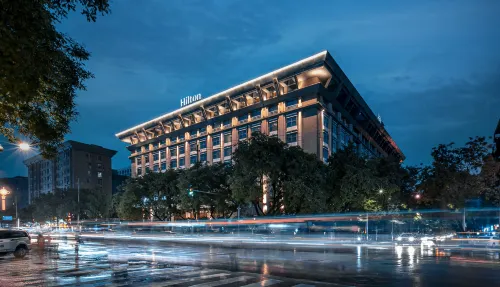



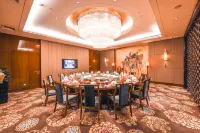


99+
Hotel near The bell tower The drum tower/The Xi’an Circumvallation,Xi'an
 No. 13 of Instagrammable Hotels in Shaanxi
No. 13 of Instagrammable Hotels in ShaanxiIndoor swimming pool
Sauna
Spa
+17
"We cannot recommend the Hilton highly enough. The location is excellent. The breakfasts are very good value for money. Laundry is a same day service. Staff are exceptional. A front desk lady, Jane, helped us with bookings to local attractions and went way beyond what anyone could expect to ensure a top class experience. Kitty, a manager in charge of front desk, was equally helpful. Staff cannot do enough for you. At one stage, we were called to check everything about our stay met our expectations. Service excellence in every respect"
Excellent
5031 reviews
9.6/10
1 night
From JPY 11,111


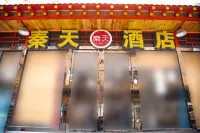



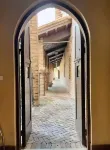
73
Hotel near Xi`an Xianyang International Airport,Xi'an
Private parking
EV charging station
Luggage storage
+11
"I booked the hotel last minute but the owner immediately came pick me up from the airport and the room was ready and clean for super reasonable price. thanks for your hospitality!"
Good
421 reviews
9.1/10
1 night
From JPY 1,904
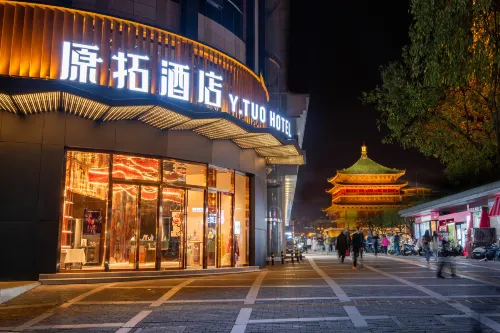






99+
Hotel near The bell tower The drum tower/The Xi’an Circumvallation,Xi'an
 No. 14 of 4-Star Select Hotels in Shaanxi
No. 14 of 4-Star Select Hotels in ShaanxiSauna
Massage room
Executive lounge
+27
"Excellent location, close to many tourist attractions and shopping malls
Metro exit is right in front of the hotel, making transportation very convenient
Friendly and helpful staff with great service
Clean and comfortable rooms
Hotel offers free parcel storage/collection service, which is very convenient
Breakfast is good with a nice variety
Great value for money, highly recommended
酒店地点非常好,靠近多个旅游景点和购物中心
地铁出口就在酒店正前方,交通十分便利
员工服务态度友善、专业,整体体验很好
房间干净整洁,入住舒适
酒店可免费代收包裹,对旅客非常贴心
早餐选择丰富、味道不错
整体性价比高,非常推荐入住"
Outstanding
3746 reviews
9.5/10
1 night
From JPY 4,010

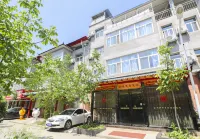





64
Hotel near Xi`an Xianyang International Airport,Xi'an
Public parking
EV charging station
Luggage storage
+8
"I chosen this hotel because it was cheap and I had to just stay a few hours before I leave for airport. It's very nearer to the airport.
The hotel offers complimentary airport pick-up and drop for 24 hours. The hotel owner himself gives this service. Very nice gentleman.
But it's located in a kind of typical chinese residential area where local residents have converted their homes into transit hotels. Nobody speak and understands english in whole of this area. Foreigners should avoid.
Only Chinese food restaurants are available. The only attraction is free airport pick-up and drop."
Outstanding
523 reviews
9.4/10
1 night
From JPY 1,680


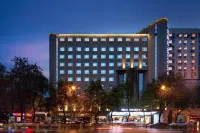


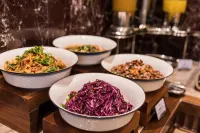

99+
Hotel near The bell tower The drum tower/The Xi’an Circumvallation,Xi'an
Gym
Private parking
Priority airport pick-up
+9
"The hotel offers airport shuttle service, which is incredibly convenient. It's also very close to the Muslim Quarter and the Bell Tower, making transportation a breeze. The nearby food options are great too. We especially loved the complimentary fruit delivered daily, the apples were particularly sweet and fragrant. The hotel provides breakfast, afternoon tea, and late-night snacks, and our room was stocked with Bingfeng and Coke every day. The overall environment is excellent, and the staff are very polite and attentive. It was a truly memorable trip. Thumbs up to the staff at Mercure Xi'an!
Airport shuttle for two: Very convenient
Afternoon tea for two: Delicious
Mini Bar: Unique
Facilities: Brand new
Cleanliness: Good
Service: Fantastic and very polite"
Excellent
4605 reviews
9.6/10
1 night
From JPY 6,385

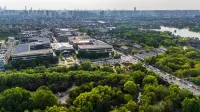


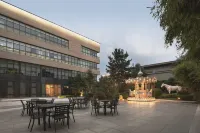

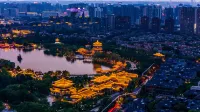
99+
Hotel near Dayan Pagoda/The Grand Tang Mall,Xi'an
 No. 7 of Premium Hotels in Xi'an
No. 7 of Premium Hotels in Xi'anIndoor swimming pool
Sauna
Executive lounge
+21
"Excellent service and ideal location
My stay in the Red Level room at the Gran Melia Xi'an was exceptionally pleasant.
The hotel boasts a very convenient location—the city's main attractions, such as the ancient city wall and the Bell and Drum Towers, are within walking distance.
I would like to specifically mention the wonderful breakfasts with a great variety of dishes.
I extend my sincere gratitude to the entire hotel staff, and especially to the Red Level executive lounge team, for their impeccable service and attention to detail. A special thank you to Daisy Liu for the heartwarming congratulatory letter—it was a very kind gesture that created a truly welcoming atmosphere.
I highly recommend this hotel for a comfortable stay in Xi'an
Отличный сервис и идеальное расположение
Проживание в номере Red Level в отеле Gran Melia Xi'an оставило исключительно приятные впечатления.
Отель находится в очень удачном месте — основные достопримечательности города, такие как древняя стена и барабанная башня, находятся в шаговой доступности.
Отдельно хочу отметить прекрасные завтраки с большим выбором блюд.
Выражаю огромную благодарность всему персоналу отеля, а особенно команде представительского этажа Red Level, за безупречный сервис и внимание к деталям. Отдельное спасибо Дейзи Лиу за тёплое поздравительное письмо — это было очень мило и создало по-настоящему домашнюю атмосферу.
Однозначно рекомендую этот отель для комфортного пребывания в Сиане."
Excellent
4288 reviews
9.6/10
1 night
From JPY 13,665
Trip.com's insights for hotels in Xi'an
Plan smarter with Trip.com’s data-backed insights on travel seasons so that you can book your Xi'an hotel at the right time!
Which month offers the lowest hotel rates in Xi'an?
December is the most affordable month to book a hotel in Xi'an, with average nightly rates around JPY 11,649. Prices peak in April, when rates reach about JPY 13,553 per night.
(Based on Trip.com data from January 6, 2025 to January 6, 2026.)
(Based on Trip.com data from January 6, 2025 to January 6, 2026.)
0
JPY 5,000
JPY 10,000
JPY 15,000
JPY 12,724
Jan
JPY 13,217
Feb
JPY 13,240
Mar
JPY 13,553
Apr
JPY 12,971
May
JPY 13,038
Jun
JPY 13,150
Jul
JPY 12,411
Aug
JPY 12,523
Sep
JPY 12,388
Oct
JPY 11,761
Nov
JPY 11,649
Dec
What is the cheapest day of the week for hotels in Xi'an?
Hotel rates in Xi'an are typically lowest on Saturday, with average nightly rates around JPY 12,366. Monday tends to be the most expensive, averaging JPY 12,904 per night.
(Based on Trip.com data from January 6, 2025 to January 6, 2026.)
(Based on Trip.com data from January 6, 2025 to January 6, 2026.)
0
JPY 5,000
JPY 10,000
JPY 15,000
JPY 12,904
Mon
JPY 12,635
Tue
JPY 12,523
Wed
JPY 12,724
Thu
JPY 12,612
Fri
JPY 12,366
Sat
JPY 12,523
Sun
How much does a hotel in Xi'an cost for tonight?
Based on bookings by Trip.com users over the past 3 days, the best deal for a 3-star hotel room in Xi'an was JPY 3,853, while the lowest price for a 4-star hotel was JPY 4,391. The most affordable 5-star hotel room was JPY 12,209.
(Based on Trip.com data from January 3, 2026 to January 5, 2026.)
(Based on Trip.com data from January 3, 2026 to January 5, 2026.)
0
JPY 5,000
JPY 10,000
JPY 15,000
JPY 1,187
2-Star
JPY 3,853
3-Star
JPY 4,391
4-Star
JPY 12,209
5-Star
What are the hotel rates in Xi'an this weekend?
Trip.com has found that weekend rates for 3-star hotels in Xi'an start as low as JPY 8,356/night. For 4-star hotels, rates start from JPY 11,268/night, while 5-star hotel rates start from JPY 24,777/night.
(Based on Trip.com data for January 3, 2026 to January 5, 2026.)
(Based on Trip.com data for January 3, 2026 to January 5, 2026.)
0
JPY 10,000
JPY 20,000
JPY 30,000
JPY 8,356
3-Star
JPY 11,268
4-Star
JPY 24,777
5-Star
Among Trip.com users, which area in Xi'an is most popular for hotel bookings?
The bell tower The drum tower/The Xi’an Circumvallation is the most popular area in Xi'an for hotel searches on Trip.com, with an average price of JPY 23,047. Center Hotel (Xi'an Bell Tower), Xi 'an Zhonglou Yuantuo Hotel, and Novotel Xi an The Bell Tower Hotel are among the top-rated hotels in The bell tower The drum tower/The Xi’an Circumvallation.
(Based on Trip.com data from January 6, 2025 to January 6, 2026.)
(Based on Trip.com data from January 6, 2025 to January 6, 2026.)
0
JPY 10,000
JPY 20,000
JPY 30,000
Dayan Pagoda/The Grand Tang Mall
JPY 23,047
Dayan Pagoda/The Grand Tang Mall
High-tech Zone
JPY 16,991
High-tech Zone
Yongning Men/Xi'an Museum
JPY 13,880
Yongning Men/Xi'an Museum
Beiguan/Longshou District
JPY 13,833
Beiguan/Longshou District
Xi'anbei Railway Station/Xi'an Municipal Government
JPY 13,139
Xi'anbei Railway Station/Xi'an Municipal Government
The bell tower The drum tower/The Xi’an Circumvallation
JPY 11,164
The bell tower The drum tower/The Xi’an Circumvallation
Hotels in Xi'an Near Popular Landmarks
Discover the top tourist attractions in Xi'an and book your hotel near the city's most famous towers and entertainment centers to enjoy a stay close to everything you want to visit.
Landmarks
Xi'an Bell Tower
1074 hotels
Xi'an City Wall
984 hotels
Shaanxi History Museum
1135 hotels
Tang Paradise
1160 hotels
Grand Tang Mall
1218 hotels
Xi'an Muslim Quarter
1065 hotels
Districts
Beilin District
387 hotels
Xincheng District
238 hotels
Lianhu District
289 hotels
Yanta District
645 hotels
Weiyang District
482 hotels
Lintong District
181 hotels
Popular areas
Yongning Men/Xi'an Museum
131 hotels
Dayan Pagoda/The Grand Tang Mall
209 hotels
High-tech Zone
270 hotels
Beiguan/Longshou District
72 hotels
Browse Hotels in Xi'an by Accommodation Type & Amenities
Discover hotels in Xi'an that match your style, from serviced apartments and countryside stays to hotels with free Wi-Fi and parking, and find the right place for your trip to Xi'an.

Premium Hotels in Xi'an
See all
Discover our curated selection of premium hotels in Xi'an for your next stay

No.
1
9.5/10
11878 reviewThe Westin Xi'an
Hotel near Dayan Pagoda/The Grand Tang Mall, Xi'an
"Delicious breakfast""Friendly front desk staff"
Select dates to view prices
No.
2
9.6/10
4820 reviewCanopy by Hilton Xi'an Qujiang
Hotel near Dayan Pagoda/The Grand Tang Mall, Xi'an
"Friendly front desk staff""Great design"
Select dates to view prices
No.
3
9.6/10
8719 reviewWyndham Grand Xi’an South
Hotel near Dayan Pagoda/The Grand Tang Mall, Xi'an
"Large rooms""Delicious breakfast"
Select dates to view prices
No.
4
9.5/10
3780 reviewHyatt Regency Xi'an
Hotel near Dayan Pagoda/The Grand Tang Mall, Xi'an
"Classy environment""Friendly front desk staff"
Select dates to view prices
No.
5
9.7/10
518 reviewYounch Hotel (Xi'an City Wall)
Hotel near The bell tower The drum tower/The Xi’an Circumvallation, Xi'an
"Quiet & comfortable""Great design"
Select dates to view prices
No.
6
9.6/10
5771 reviewRenaissance Xi'an Hotel
Hotel near Dayan Pagoda/The Grand Tang Mall, Xi'an
"Friendly front desk staff""Large rooms"
Select dates to view prices
No.
7
9.6/10
4288 reviewGran Melia Xi'an
Hotel near Dayan Pagoda/The Grand Tang Mall, Xi'an
"Delicious breakfast""Friendly front desk staff"
Select dates to view prices
No.
8
9.6/10
7038 reviewHUALUXE Hotels and Resorts XI'AN TANGHUA
Hotel near Dayan Pagoda/The Grand Tang Mall, Xi'an
"Classy environment""Garden view"
Select dates to view prices
No.
9
9.5/10
5977 reviewAngsana Xi'an Lintong
Hotel near Terracotta Army/Hua Qing Palace, Xi'an
"Relaxing hot springs""Great for kids"
Select dates to view prices
No.
10
9.6/10
7592 reviewFu Rong Ge Hotel
Hotel near Dayan Pagoda/The Grand Tang Mall, Xi'an
"Delicious breakfast""Friendly front desk staff"
Select dates to view prices
No.
11
9.5/10
1153 reviewTang Paradise Hotel
Hotel near Dayan Pagoda/The Grand Tang Mall, Xi'an
"Classy environment""Garden view"
Select dates to view prices
No.
12
9.6/10
7364 reviewJW Marriott Hotel Xi'an
Hotel near Xi'anbei Railway Station/Xi'an Municipal Government, Xi'an
"Easy to get around"
Select dates to view prices
No.
13
9.6/10
8915 reviewInterContinental Hotels XI'AN NORTH by IHG
Hotel near Xi'anbei Railway Station/Xi'an Municipal Government, Xi'an
"Delicious breakfast""Close to metro"
Select dates to view prices
No.
14
9.6/10
4208 reviewGrand Hyatt Xi'an
Hotel near High-tech Zone, Xi'an
"Friendly front desk staff""Delicious breakfast"
Select dates to view prices
No.
15
9.7/10
4119 reviewJW Marriott Hotel Xi'an Southwest
Hotel near High-tech Zone, Xi'an
"Friendly front desk staff""Delicious breakfast"
Select dates to view prices
No.
16
9.7/10
7637 reviewInterContinental Hotels XI'AN HI-TECH ZONE by IHG
Hotel near High-tech Zone, Xi'an
"Delicious breakfast""Friendly front desk staff"
Select dates to view prices
No.
17
9.5/10
6579 reviewShangri-La Xi'an
Hotel near High-tech Zone, Xi'an
"Friendly front desk staff""Delicious breakfast"
Select dates to view prices
No.
18
9.6/10
5031 reviewHilton Xi'an
Hotel near The bell tower The drum tower/The Xi’an Circumvallation, Xi'an
"Delicious breakfast""Easy to get around"
Select dates to view prices
No.
19
9.6/10
12756 reviewSheraton Xi'an North City Hotel(Longshouyuan Subway Station Store)
Hotel near Beiguan/Longshou District, Xi'an
"Easy to get around""Delicious breakfast"
Select dates to view prices
No.
20
9.6/10
3936 reviewCrowne Plaza XI'AN WEIYANG by IHG
Hotel near Beiguan/Longshou District, Xi'an
"Delicious breakfast""Friendly front desk staff"
Select dates to view pricesMost Booked Hotels in Xi'an by Travellers This Past Month
See all
A curated selection of most in-demand Xi'an hotels, based on an analysis of booking trends, guest reviews, and ratings for quality and cleanliness.
No.1
9.5/10
4565 reviewCenter Hotel (Xi'an Bell Tower)
Hotel near The bell tower The drum tower/The Xi’an Circumvallation, Xi'an 21.8% of visitors choose this area
"Easy to get around""Convenient location"
Select dates to view pricesNo.2
9.5/10
11395 reviewOrangeHao Hotel
Hotel near Yongning Men/Xi'an Museum, Xi'an 7.9% of visitors choose this area
"Convenient location""Easy to get around"
Select dates to view pricesNo.3
9.5/10
1389 reviewHeSu Hidden Art Hotel & Suites: Exclusive 2-3 Bedroom Family Suites+Curated Itineraries+Cat Coffee
Hotel near Yongning Men/Xi'an Museum, Xi'an 7.9% of visitors choose this area
"Friendly front desk staff""Great design"
Select dates to view pricesNo.4
9.8/10
14528 reviewYun He Ye Bo Hotel (Xi'an Zhonggulou South Gate)
Hotel near Yongning Men/Xi'an Museum, Xi'an 7.9% of visitors choose this area
"Delicious breakfast""Friendly front desk staff"
Select dates to view pricesNo.5
9.4/10
4816 reviewMcsrh Hotel (Xi'an Bell and Drum Tower Branch)
Hotel near The bell tower The drum tower/The Xi’an Circumvallation, Xi'an 21.8% of visitors choose this area
"Easy to get around""Convenient location"
Select dates to view pricesNo.6
9.2/10
3189 reviewYunqi Selected Hotel (Bell and Drum Tower Huimin Street)
Hotel near The bell tower The drum tower/The Xi’an Circumvallation, Xi'an 21.8% of visitors choose this area
"Convenient location""Easy to get around"
Select dates to view pricesNo.7
9.6/10
1172 reviewTongpai Hotel Xi'An Bell Tower Yongning Gate
Hotel near The bell tower The drum tower/The Xi’an Circumvallation, Xi'an 21.8% of visitors choose this area
"Easy to get around""Convenient location"
Select dates to view pricesNo.8
9.4/10
1623 reviewSkanhem Hotel Xi'an Bell Tower subway station
Hotel near The bell tower The drum tower/The Xi’an Circumvallation, Xi'an 21.8% of visitors choose this area
"Easy to get around""Friendly front desk staff"
Select dates to view pricesNo.9
9.4/10
2206 reviewElegant Hotel Xi'an Bell Tower Yongningmen
Hotel near The bell tower The drum tower/The Xi’an Circumvallation, Xi'an 21.8% of visitors choose this area
"Friendly front desk staff""Great design"
Select dates to view pricesNo.10
9.5/10
4688 reviewDesti Youth Park Hostel (Xi'an Bell Tower)
Hotel near The bell tower The drum tower/The Xi’an Circumvallation, Xi'an 21.8% of visitors choose this area
"Great stay!""Easy to get around"
Select dates to view pricesBest Xi'an hotels with breakfast
See all
Start your day with a tasty breakfast at one of our top hotels in Xi'an.
Xi'an Airport Hotel
Hotel near Xi`an Xianyang International Airport, Xi'an 87.4% of visitors choose this area
The Xi'an Airport Hotel provides a great place for travelers to relax after a busy day. The Xi'an Airport Hotel offers a pleasant stay in Xi'an for those traveling for business or leisure. The hotel is only 900m from Xi'an Xianyang International Airport and 9km from Xianyangbei Railway Station, giving guests a number of convenient transportation options. In addition, Airport W. (T1,T2,T3) Metro Station is just a short walk away. With multiple attractions nearby including Xi'an Xianyang International Airport Complex Venue, Xi'an International Art City and Tangshun Mausoleum, guests will find plenty to keep themselves occupied. After a long day of sightseeing, guests can retire to the comfort of the hotel. This Xi'an hotel offers parking on site. If cleanliness is important to you, this hotel makes an excellent choice, as our guests consider this to be one of the cleanest hotels in the city. This hotel is a popular accommodation for guests traveling for business.
9.3/10
Very Good3879 reviewPrice per night from:JPY 7,841
The Westin Xi'an
Hotel near Dayan Pagoda/The Grand Tang Mall, Xi'an 13.5% of visitors choose this area
Located right opposite of over 1300 years famous historical site Great Wild Goose Pagoda and adjacent to Grand Tang Everbright City, boasting an on-site Chinese fine arts museum with over 2000 artifacts, The Westin Xian offers a luxurious getaway experience in the capital city of 13 royal dynasties in Ancient China. The hotel features spacious and stylish rooms with Great Tang Dynasty design, Besides an indoor pool, it also offers guests refreshing workouts at Westin WORKOUT® Gym, relaxing massages and signature body treatments at Spa . Free tickets to Xi’an Qu Jiang Museum of Fine Arts are provided to in-house guests. The popular Westin Heavenly Bed® comes with down pillows and duvet. Every room is equipped with upgraded smart TV. Private bathrooms have a separate shower and bathtub, complete with hi-tech electrical toilet seat cover that ensures every guest’s comfort in all 4 seasons. Free Wi-Fi is available throughout the property. The famous Qin Terracotta Warriors are 21 mi away. It is about 19 mi from Xianyang International Airport. Free parking is available. Day trips and limousine transfers can be arranged at the tour desk or concierge counter.
Guests can enjoy meals from the in-house restaurants, 24-hour rooms service or have a drink at the bar. Seasonal Tastes, located on G Level, is the hotel’s signature dining venue, offering local Chinese, Asian to international cuisine. Mai Japanese Restaurant, is also a gastro bar serving Authentic Japanese cuisine, paired with a carefully curated selection of sake, beer, wine and cocktails. Local Shaanxi and Cantonese delights and exclusive service are offered at Five Zen5es Chinese Restaurant that has direct access to the main bustling street. Desserts and drinks are at MIX Bar and Lobby Lounge.
9.5/10
Outstanding11878 reviewPrice per night from:JPY 15,368
HUAQING PALACE RESORT & SPA
Hotel near Terracotta Army/Hua Qing Palace, Xi'an
The Xi’an Hua Qing Palace Hotel & Spa (Xi’an Huaqing Yutang Jiudian) is situated in Hua Qing Palace scenic area. This Xi'an hotel is situated 43 km (27 mi) from the Xianyang International Airport, and 30 km (19 mi) from the Xi'an Railway Station.Diners can enjoy local dishes at the on-site restaurant.In your spare time, relax in the hot springs, spa or with a massage. This Xi’an hotel provides free Wi-Fi in public areas and rooms as well as free parking on site.
9.7/10
Excellent1995 reviewPrice per night from:JPY 29,011
Four Points By sheraton Xi'An Bell Tower
Hotel near The bell tower The drum tower/The Xi’an Circumvallation, Xi'an 21.8% of visitors choose this area
Located in Xi'an's Downtown Tourist AreaNestled in the downtown tourist district of Xi'an, the hotel is surrounded by attractions such as the Bell Tower, Drum Tower, and Huimin Street Food Street. Boasting 214 luxury guest rooms, the hotel offers guests panoramic views of Xi'an's iconic landscapes, ancient neighborhoods, and urban scenery. Our "Curated Beer" Program – which provides on-site service of local specialty craft beers – is just one example of how everything we do reflects our respect for exceptional design and recognition of local culture.Start your day with a delicious breakfast and savor a unique local culinary experience. In the evening, unwind in a relaxed, modern dining setting. Additionally, the hotel provides free Wi-Fi coverage throughout the premises, allowing guests to work efficiently while staying socially connected.Furthermore, during your comfortable stay, exercise options are not limited to the gym. The hotel is designed to provide business travelers and family tourists with all the essential facilities needed for relaxation and leisure.
9.7/10
Excellent369 reviewPrice per night from:JPY 14,785
JW Marriott Hotel Xi'an
Hotel near Xi'anbei Railway Station/Xi'an Municipal Government, Xi'an 20.4% of visitors choose this area
Opened in 2023, the JW Marriott Hotel Xi'an is a great accommodation choice in Xi'an. Traveling to the hotel is easy with Xi'an North Railway Station located approximately 5km away and Xi'an Xianyang International Airport roughly 28km away. Just a short walk from Wenjinglu Metro Station, traveling to most city destinations is a breeze. The nearby area boasts an abundance of attractions including Archaeological Park (Hanshin Shopping Plaza Wenjing Store), Xi'an City Sports Park and Kaiyuan Grand Theater. In their spare time, guests can explore the hotel's surroundings. For those driving themselves, parking is provided on site. There's never a dull moment at this hotel, our guests indicate that the facilities are excellent. Perfect for those working on the move, this hotel caters to a large number of business guests.
9.6/10
Excellent7364 reviewPrice per night from:JPY 13,419
Wyndham Grand Xi’an South
Hotel near Dayan Pagoda/The Grand Tang Mall, Xi'an 13.5% of visitors choose this area
WYNDHAM GRAND XIAN SOUTH is situated at the key position of the prestigious tourism site ‘Great Tang All Day Mall’ in Qujiang New District in Xi'an, just minutes away from Dayan Pagoda, international shopping centers, business pedestrian street and many famous historic heritage sites. The tourism site is famous for its series of Tang style performances and activities. WYNDHAM GRAND is the top brand of the Wyndham family, and WYNDHAM GRAND XIAN SOUTH is the first luxury hotel under direct management of Wyndham Group in China. Hotel was listed on TripAdvisor as Top 25 Hotels-China(2017-2019 travelers’ choice)Apart from the ideal location, WYNDHAM GRAND XIAN SOUTH is designed with both contemporary style and traditional Chinese architectural influence. 565 spacious, elegant and comfortable guest rooms and suites. The hotel brings 5-star dining experiences to a high level of creativity, presenting cuisines from around the world, as well as local favorites at the astonishing restaurants and bars. The hotel also provides an elegant setting for hosting high-level meetings and upscale private events. The versatility of our meeting and function rooms makes event planning an enjoyable experience WYNDHAM GRAND XIAN SOUTH.
9.6/10
Excellent8719 reviewPrice per night from:JPY 14,225
The Ritz-Carlton, Xi'an
Hotel near High-tech Zone, Xi'an 2.7% of visitors choose this area
Known as ‘the cradle of Chinese civilization’, Xi’an is the ancient provincial capital of Shaanxi located in the central-northwestern region of China. With a history that spans thousands of years, Xi’an is one of China’s four ancient capitals and former home to thirteen imperial Chinese dynasties. The city marks the eastern end of the ancient Silk Road and today is a key crossroad to one of the country’s most important trading corridors. Located in the central business area of Gao Xin District, The Ritz-Carlton, Xi’an boasts a privileged access to a variety of historical and cultural sites, including the legendary Terracotta Warriors, Great Wild Goose Pagoda and old City Walls. Designed by Remedios Studio, the hotel’s interior design pays homage to architectural and design elements drawn from the history and culture of Xi’an. Patterned motifs created by local artisans offer a unique social meeting space for visitors as well as the local community.
9.5/10
Outstanding6217 reviewPrice per night from:JPY 24,642
Platinum wan'ao Victory Hotel
Hotel near Xi'an Jiaotong University/Lijaicun, Xi'an
The Platinum wan'ao Victory Hotel provides a great place for travelers to relax after a busy day. The Platinum wan'ao Victory Hotel is an ideal choice for travelers who want to take in the sights and sounds of Xi'an. With Xi'an Railway Station just 3km away and Xi'an Xianyang International Airport only 39km away, transportation is very convenient. The closest major public transportation, Hepingmen Metro Station, is only 100m away. There is no shortage of things to see in the area, with the Old Market Cultural and Creative District, Shuyuanmen Street of Culture and Xi'An Incident Memorial all nearby. After a long day of sightseeing, guests can retire to the comfort of the hotel. For those driving themselves, parking is provided on site. Our guests rate this hotel as one of the best hotels for cleanliness. For guests traveling with families, this hotel is consistently one of the most popular choices.
9.5/10
Outstanding4332 reviewPrice per night from:JPY 7,146
W XI'AN
Hotel near Dayan Pagoda/The Grand Tang Mall, Xi'an 13.5% of visitors choose this area
The W XI'AN provides a great place for travelers to relax after a busy day. The W XI'AN offers a pleasant stay in Xi'an for those traveling for business or leisure. The hotel is conveniently located just 14km from Xi'an Railway Station and 54km from Xi'an Xianyang International Airport. Transportation around the city is also convenient, with HANYAO Metro Station within walking distance. Seeing Xi'an's sights from this hotel is easy with Explore Zootopia, Qujiang Pool Heritage Park and Qujiang Cold Kiln Ruins Park all close by. When guests have some time on their hands they can make use of the onsite facilities. This Xi'an hotel features parking on site. There's never a dull moment at this hotel, our guests indicate that the facilities are excellent. This hotel is particularly popular with those traveling with families.
9.6/10
Excellent9739 reviewPrice per night from:JPY 24,351
Novotel Xi'an Daming Palace
Hotel near Beiguan/Longshou District, Xi'an
The hotel is a high-end hotel brand that provides full services. The hotel is located in the North Railway Station business district, adjacent to the city wall to the south, and to the east the national 5A tourist attraction Daming Palace Heritage Park. It is 3 stops away from the Xi'an Bell Tower subway. To the right of the hotel is Longshouyuan. The location of the subway station is very advantageous. There are many shopping malls and shopping malls nearby. Next to it is the famous Weiyang Night Market, which provides tourists and local residents with a wealth of shopping and entertainment. It is a good choice for your tourism and business trips. The hotel adheres to the Novotel brand standards. The hotel has 5 large and small conference rooms, a gym, a billiards room, a laundry room, an executive lounge, a children's experience area and other unique and modern service facilities that will make you feel more comfortable and comfortable. The hotel has the largest scale The underground parking lot is divided into two floors - negative 2 and negative 3, with 1,200 parking spaces, which solves the parking problem of hotel guests. Adding more convenience for guests to enjoy business travel and vacation life.
9.6/10
Excellent3456 reviewPrice per night from:JPY 8,311
Verified Reviews From Guests at Xi'an Hotels
See all
Browse these genuine traveler ratings and real guest reviews to find the best Xi'an hotels.
9.7/10
Excellent
TTinaMThis is a lovely hotel with kind, welcoming staff. I read some reviews saying the rooms are very old etc, but I don't see how that makes this hotel any less great - the rooms are still clean and well maintained. I arrived in Xi'an after 48 hours of hectic traveling due to a missed train, and the staff at Meihao Hotel were very welcoming, were happy to use translation apps to communicate with me. The room was large, with a view of the neighbourhood outside (mostly just traffic jams haha, but that's Xi'an). The location may not be super ideal for some as it isn't in the city centre, but honestly it was no inconvenience at all, as the nearest subway station is a brisk walk away -- about 5-7 minutes. If you're arriving by train and carrying a lot of heavy luggage, then yes, coming via subway might be a bit of a challenge (but not impossible!)
The housekeeping staff especially were very warm and kind. Thank you for always brightening my day when I walked by you all.
A few hours after I checked in, a lovely staff member knocked on my door and offered me a small bowl of soup. I was very confused as I hadn't ordered anything, but upon seeing other guests were receiving this too, I gladly accepted. It was such an unexpected, kind gesture -- this hotel truly knows how to make one feel welcome.
I fell ill on the second day of my stay, and thankfully the room was so comfortable, I could recuperate well. My only complaint is that the bedsheets, comforter, pillowcases etc -- all the bedding essentially smells of cigarette smoke. I could also smell cigarette smoke from beyond my room's door at night. This was despite there being a clear sign in the room saying smoking was not allowed inside. Though this is certainly not something you can fault hotel staff for (if guests are adamant to smoke inside, what can housekeeping possibly do?), I just thought I would mention this for any other guests who might be very sensitive to the smell, perhaps you could request staff to rewash the bedding until the smoke smell is entirely gone.
After checking out, I also noticed there were some freebies that were part of my booking that I unfortunately missed out on :( There was meant to be welcome fruit, afternoon tea for two and a midnight snack, which I would have loved to try. There was no welcome fruit offered, but I did receive some refreshing juice when I arrived to check in -- it was a hot day and I was grateful for the welcome drink. For the other stuff, as I didn't realise it was part of the booking perks, I never asked, and consequently seem to have missed out.
I also want to say that aside from the rooms, the lobby area is quite lovely -- very tastefully decorated, peaceful, and I even saw they had some free coffee out for guests! I only noticed this when I was checking out though, and my taxi was already on the way to pick me up, so I could not indulge. Maybe it would be helpful if the reception staff could share all this info with guests when they check in, especially with the foreign guests who are already a bit confused and trying to get their bearings ^-^ Just a suggestion! Thank you for a nice stay. I will definitely be back again soon.
Mehood Hotel (Xi'an Gaoxin Zhongda International Keji Road Subway Station)
Hotel near High-tech Zone, Xi'an 2.7% of visitors choose this area
Price per night from:JPY 5,937
9.6/10
Excellent
FFFAVAThe hotel's entrance signage was unclear, and I almost went to the wrong door, as there are three hotels within the same complex. I'm not sure if it was due to a slight delay in check-in, but the front desk upgraded our room, which was a pleasant surprise. Overall, the room was pretty well-maintained, though it had a couple of minor flaws: the bathroom door didn't close tightly, and there was a noticeable dent on the floor. The service was enthusiastic, but their efficiency and execution could be improved. The dinner at the Italian restaurant was delicious. I particularly enjoyed the egg white omelet and black sesame paste for breakfast, both of which I haven't seen offered at other hotels. The complimentary fruit in the room wasn't of great quality; the pepino melon, for instance, was unripe. The TWG tea and bottled mountain spring water in the room, however, were fitting for a hotel of this caliber. The hotel also boasts a beautiful garden at the back. My lasting impressions of this hotel are its French romantic architecture and the delightful fragrance of osmanthus flowers.
Sofitel Legend People's Grand Hotel Xian
Hotel near The bell tower The drum tower/The Xi’an Circumvallation, Xi'an 21.8% of visitors choose this area
Price per night from:JPY 28,540
9.6/10
Excellent
MM418704****Yishang Hotel was such a pleasant surprise! The Nordic-style design was simple and elegant, the rooms were clean and spacious, and the mattresses were soft and comfortable for a good night's sleep. Xiao He at the front desk was warm and efficient, making check-in and check-out incredibly smooth. The high-speed internet and the separate wet and dry bathroom were very practical. The breakfast offered a rich and delicious selection of both Western and Chinese options, with excellent value for money. Highly recommended for business or leisure travel! The rooms were also quite soundproof, and the service was excellent!
Yishang Hotel (Yongxingfang Branch, Chaoyangmen, Xi'an)
Hotel near The bell tower The drum tower/The Xi’an Circumvallation, Xi'an 21.8% of visitors choose this area
Price per night from:JPY 4,324
9.6/10
Excellent
GGuest UserExceptional hotel, my new favourite in China. Stunning interior design, excellent service, delicious breakfast provided. The entire feel of the hotel is relaxing and we appreciated the design, particularly the bell tower viewing platform. Although too cold to use in winter, the pool looked amazing. It was unbelievably quiet for being in such a busy area, you can’t hear any external noise. Fantastic for the price, we also received complimentary glass of red wine and whisky each night, which were also great quality. Will be coming back to stay.
MEILIE Ling Hotel
Hotel near The bell tower The drum tower/The Xi’an Circumvallation, Xi'an 21.8% of visitors choose this area
Price per night from:JPY 18,056
9.5/10
Outstanding
TtheAiiNVery very convenient hotel. Near the muslim quarters so have a lot of halal food available. Only thing is that there is no bidet in the toilet. Otherwise, it is a perfect hotel! Liuhao was really good & try his best to converse in English. Very friendly! Will come this hotel again if I come to Xi’An!
MEHOOD ELEGANT Hotel (Xi'an Bell and Drum Tower Huimin Street Branch)
Hotel near The bell tower The drum tower/The Xi’an Circumvallation, Xi'an 21.8% of visitors choose this area
Price per night from:JPY 5,332
9.5/10
Outstanding
2206026****The front desk service was excellent, and the room was clean and well-equipped. The hotel's location is super convenient, right near the Bell and Drum Tower and the Muslim Quarter. The breakfast was also rich and delicious. Overall, a great trip!
Meibo Hotel (Xi'an Bell Tower Metro Station Branch)
Hotel near The bell tower The drum tower/The Xi’an Circumvallation, Xi'an 21.8% of visitors choose this area
Price per night from:JPY 3,786
9.5/10
Outstanding
JJijirulvlingiThe front desk staff were warm and attentive. Free parking was available during our stay, and the breakfast offered a rich variety. The room was clean and tidy with complete amenities. There was black tea available at the front desk, and a small sofa in the lobby for resting, which was very nice. The surrounding area has convenient transportation. Highly recommended!
Starway Hotel (Xi'an Keji Road Subway Station)
Hotel near High-tech Zone, Xi'an 2.7% of visitors choose this area
Price per night from:JPY 4,615
9.5/10
Outstanding
GGuest UserWhen we visited Xi'an with our kids, the hotel upgraded us to a tatami room with a courtyard. The room was very spacious and had a small private courtyard where we could dry clothes.
The hotel's back exit leads directly to the Grand Tang Everbright City, which was incredibly convenient. We planned our city sightseeing during the day, and in the evenings, we ordered takeout to the hotel (there were plenty of options nearby), before taking the kids for a stroll at the Grand Tang Everbright City.
The room was very clean, and the service was excellent. Upon check-in, they added us on WeChat, and any requests we had were promptly addressed via WeChat.
Breakfast was also very generous. The kids particularly loved the hotel's soy milk, sausages, and cookies.
Highly recommended! Definitely staying here again on our next trip to Xi'an!
Yaman Oriental Courtyard Hotel(Xi'an Big Wild Goose Pagoda Datang Evernight City
Hotel near Dayan Pagoda/The Grand Tang Mall, Xi'an 13.5% of visitors choose this area
Price per night from:JPY 14,539
9.4/10
Outstanding
GGuest UserThe facilities were good, staff were generally helpful and nice. Very clean environment; generally has what you need. Very conveniently located. Some of the staff at the front desk are a bit too immature and could act a bit more professional. Apparently, they find it funny for you ask them for water; ask them a few more times and they would giggle and laugh behind your back and make fun of you; they might even horse around with you if Mandarin is not your first language and you don't speak as natively as they do. I made an add on booking for an extra night. If you need them to do anything towards the end of your stay, they might withhold service at the front desk until you give them a perfect rating; they wouldn't check me back in the hotel until I left a good rating/comment for my first booking. They forgot I that I could also rate / comment for my second booking. Basically a bunch of kids. Otherwise, hotel management seems fine. Pretty clean, the staff were generally polite.
Ibis Hotel (Xi'an Bell Tower Yongning Gate)
Hotel near Yongning Men/Xi'an Museum, Xi'an 7.9% of visitors choose this area
Price per night from:JPY 3,652
8.2/10
__WeChat367072****The environment is good, hygienic and clean, and the service is very enthusiastic. It is very close to Xijing Hospital. The rent is not expensive and the price is high. It is very suitable for travelers with low requirements.
Family Hotel (Xi 'an Xijing Hospital Store)
Hotel near Xijing Hospital/Tonghua Men, Xi'an
Price per night from:JPY 762
FAQs About Xi'an Hotels
What are the best places to stay in Xi'an?
Some top places to stay in Xi'an are near popular attractions like Xi'an Bell Tower, Xi'an City Wall and Shaanxi History Museum—so you can quickly get to top landmarks and amenities you need.
What is the average price of a hotel in Xi'an for this weekend?
According to Trip.com’s latest 12-month data, 3-star hotels in Xi'an have an average price of JPY 10,105 per night this weekend. For 4-star hotels, the average rate is JPY 13,009 per night. If you’re seeking luxury, 5-star hotels in Xi'an typically cost JPY 29,989 per night this weekend.
What is the average nightly price of hotels in Xi'an on weekdays?
Based on Trip.com’s latest 12-month data, the average nightly rate for 3-star hotels in Xi'an on weekdays is JPY 9,712. For 4-star hotels, the average cost is around JPY 12,691 per night. For a luxury stay, 5-star hotels in Xi'an generally have an average price of JPY 29,529 per night on weekdays.
What are the best family-friendly hotels in Xi'an?
For families traveling to Xi'an, great family hotel picks are Center Hotel (Xi'an Bell Tower) (price from JPY 4,216), Xi 'an Zhonglou Yuantuo Hotel (price from JPY 3,319) and Novotel Xi an The Bell Tower Hotel (price from JPY 4,934), which are praised for their family-oriented features like spacious rooms and kid-friendly services.
What are the best pet-friendly hotels in Xi'an?
Xinghe Yingsu (Xi'an Railway Station Wulukou Subway Station) (price from JPY 784), Honglu Garden Hotel (Xi'an Zhonggulou Huimin Street Branch) (price from JPY 5,831) and Boffo L Hotel (price from JPY 11,415) welcome pets. Bring your pets along for an enjoyable stay!
What hotels in Xi'an offer an especially good breakfast?
Begin your day with a tasty and satisfying breakfast! Novotel Xi an The Bell Tower Hotel (price from JPY 4,934), EASTERN HOUSE(Near Bell&Drum Tower City Wall) (price from JPY 8,702) and Elegant Hotel Xi'an Bell Tower Yongningmen (price from JPY 4,463) provide the best breakfast to start your day.
Which hotels in Xi'an provide fitness facilities?
Xi 'an Zhonglou Yuantuo Hotel (price from JPY 3,319), Novotel Xi an The Bell Tower Hotel (price from JPY 4,934) and OrangeHao Hotel (price from JPY 1,973) include fitness facilities, so you can maintain your routine while traveling. Stay on track with your fitness goals while on the go!
What are the best hotels with a spa in Xi'an?
A spa hotel can make your trip more enjoyable with relaxing amenities. The Westin Xi'an (price from JPY 16,170), HUAQING PALACE RESORT & SPA (price from JPY 30,233) and Hilton Xi'an (price from JPY 9,262) are great choices for spa hotels offering quality services.
What hotels in Xi'an are best for couples?
For couples traveling to Xi'an, many prefer staying at Center Hotel (Xi'an Bell Tower) (price from JPY 4,216) Other popular hotels for couples in Xi'an include HeSu Hidden Art Hotel & Suites: Exclusive 2-3 Bedroom Family Suites+Curated Itineraries+Cat Coffee (price from JPY 3,992) and EASTERN HOUSE(Near Bell&Drum Tower City Wall) (price from JPY 8,702).
What are the best hot spring hotels in Xi'an?
Hotels with hot springs provide a perfect way to relax and recharge during your stay. HUAQING PALACE RESORT & SPA (price from JPY 30,233), Angsana Xi'an Lintong (price from JPY 7,401) and YOYA RESORT (price from JPY 15,677) include hot springs for a truly relaxing experience.
Which hotels in Xi'an have pools?
Sheraton Xi'an North City Hotel(Longshouyuan Subway Station Store) (price from JPY 9,868), Xi'an Airport Hotel (price from JPY 7,849) and The Westin Xi'an (price from JPY 16,170) are excellent options for hotels with swimming pools. Book your stay to enjoy the pool and make your trip more enjoyable.
What are the best hotels in Xi'an near Xi'an Bell Tower?
Some standout hotels in Xi'an close to Xi'an Bell Tower include EASTERN HOUSE(Near Bell&Drum Tower City Wall) (price from JPY 8,702), Feeling Hotel (price from JPY 1,996) and Elegant Hotel Xi'an Bell Tower Yongningmen (price from JPY 4,463), all within easy walking or transit distance of Xi'an Bell Tower, perfect for travelers wanting to explore the landmark and its surroundings.
How to get good deals on hotels in Xi'an?
Find the best hotel deals and promotions on Trip.com, available year-round for both first-time and loyal users. Please check the promotions page to see what promotions are available now on Trip.com.
Xi'an Hotels Info
Number of Reviews
2,937,671
Total Properties
2916
Weekday Avg. Price
JPY 6,729
Weekend Avg. Price
JPY 6,966
Trending hotel
Center Hotel (Xi'an Bell Tower)
Popular area
The bell tower The drum tower/The Xi’an Circumvallation
Keep Exploring Xi'an
Most Viewed Xi'an Hotels
Jingxin HotelElong WG Hotel (Yongningmen Branch Near Xi'an Museum)Sheraton Xi'an North City Hotel(Longshouyuan Subway Station Store)OrangeHao HotelNovotel Xi an The Bell Tower HotelShanxi Tianyu Fields International HotelJin Jiang West Capital International HotelElegant Hotel Xi'an Bell Tower YongningmenAyhausen Hotel (Xi'an North Street Anyuanmen Subway Station Branch)Ramada Bell Tower Hotel Xi'anHUAQING PALACE RESORT & SPASheraton Xi'an SouthCenter Hotel (Xi'an Bell Tower)Holiday Inn Express XI'AN NORTH by IHGXitang InnYangyang International HotelCOME HOTELPlatinum wan'ao Victory HotelZhongjing Elegant Hotel (Xi'an Mingcheng Wall Railway Station Subway Station)Huanxi Hotel (Xi'an Qiaozikou Subway Station Branch)
Xi'an Hotels near Attractions
Hotels near Xi'an Rock Carving Art RoomHotels near Jinshi SquareHotels near Daming Palace National Heritage ParkHotels near Jianguo Hotel - Badminton CourtHotels near Kenneth Behring Natural History MuseumHotels near Tang ParadiseHotels near Yannan San Lu Jie Xin GardenHotels near Xi'an Beilin MuseumHotels near Dayan Pagoda North SquareHotels near Xuanwumen Relic SiteHotels near Big Wild Goose Pagoda North Square Music FountainHotels near Xi'an City WallHotels near Shaanxi History MuseumHotels near Xi'an Muslim QuarterHotels near Tumenxiao Shulin ParkHotels near Small Wild Goose Pagoda Heritage ParkHotels near Qujiang Polar Ocean ParkHotels near Qinhan Civilization MuseumHotels near Yong Ning GateHotels near Big Wild Goose PagodaHotels near Emperor Qinshihuang's Mausoleum Site MuseumHotels near Shangtiantai RuinsHotels near Huaqing PalaceHotels near The Former Residence of Gao YuesongHotels near Baqiao Ecology Wetland Park (Southeast Gate)Hotels near Xingqing Palace ParkHotels near Xi'an University of Science & TechnologyHotels near Xi'an Bell TowerHotels near Grand Tang MallHotels near Xi'an Drum TowerHotels near Xi'an Xianyang International Airport
Trending Flights to Xi'an
Cheap flights from Qingdao to Xi'anCheap flights from Minsk to Xi'anFlights from Islamabad to Xi'anBest offers Lahore to Xi'an flightsFlights from Jinan to Xi'anCheap flights from Yiwu to Xi'anBest offers Mumbai to Xi'an flightsCheap flights from Ho Chi Minh City to Xi'anFlights from Beijing to Xi'anFlights from Addis Ababa to Xi'anBest offers Kunming to Xi'an flightsFlights from Harbin to Xi'anCheap flights from Hong Kong to Xi'anBest offers Lijiang to Xi'an flightsFlights from Phuket to Xi'anCheap flights from Shanghai to Xi'anCheap flights from Weihai to Xi'anFlights from Zhangjiajie to Xi'anCheap flights from Wuhan to Xi'anBest offers Jining to Xi'an flightsFlights from Kashgar to Xi'anFlights from Kuala Lumpur to Xi'anCheap flights from Abu Dhabi to Xi'anBest offers Hangzhou to Xi'an flightsFlights from Rizhao to Xi'anCheap flights from Sharjah to Xi'anBest offers Chengdu to Xi'an flightsBest offers Chongqing to Xi'an flightsFlights from Almaty to Xi'anCheap flights from Dubai to Xi'an
Trending Flights From Xi'an
Flights from Xi'an to BhubaneswarCheap flights from Xi'an to Ganzi CountyFlights from Xi'an to NottinghamBest offers Xi'an to Yanbu flightsFlights from Xi'an to LhasaBest offers Xi'an to Barkol flightsFlights from Xi'an to PadangBest offers Xi'an to Sulaymaniyah flightsFlights from Xi'an to MontevideoFlights from Xi'an to MalmoBest offers Xi'an to Karratha flightsFlights from Xi'an to KelownaFlights from Xi'an to HuatugouCheap flights from Xi'an to NagpurCheap flights from Xi'an to Bandar LampungCheap flights from Xi'an to BergenBest offers Xi'an to Kailua-Kona flightsFlights from Xi'an to HartfordBest offers Xi'an to Dubai flightsCheap flights from Xi'an to SandakanFlights from Xi'an to GuwahatiCheap flights from Xi'an to CorfuCheap flights from Xi'an to GeorgeBest offers Xi'an to Manokwari flightsCheap flights from Xi'an to MadisonFlights from Xi'an to LeedsXi'an to Siem Reap FlightsBest offers Xi'an to Beijing flightsFlights from Xi'an to GuilinBest offers Xi'an to Port Blair flights
Flights to Trending Cities
Cheap flights to SplitCheap airline to RiminiCheap flights to DubaiCheap flights to Abu DhabiRound-trip flights to SamanaCheap flights to LaolingRound-trip flights to AdareilCheap flights to WangeroogeCheap airline to BarcelonnetteCheap airline to DonegalCheap airline to Choiseul BayCheap airline to BIARURound-trip flights to GambelaCheap airline to LifouCheap flights to CraneRound-trip flights to NosaraCheap flights to MpandaCheap airline to NeuquenRound-trip flights to MeraukeCheap flights to GinbataRound-trip flights to HillsideRound-trip flights to Rodrigues IslandCheap airline to TaupoCheap flights to Bien HoaCheap flights to GuarulhosCheap airline to HimejiCheap flights to HaysRound-trip flights to CumbernauldCheap airline to SalouRound-trip flights to Sitges
Trending hotels in other cities
Hotels in DubaiHotels in New YorkHotels in OsakaHotels in MoscowHotels in SingaporeHotels in RiyadhHotels in Genting HighlandsHotels in DuluthHotels in PhuketHotels in VailHotels in Hong KongHotels in VancouverHotels in DohaHotels in DavaoHotels in ShenzhenHotels in MakkahHotels in Quezon CityHotels in Mammoth LakesHotels in BaliHotels in GuangzhouHotels in Ras Al KhaimahHotels in Ho Chi Minh CityHotels in CoronHotels in ZurichHotels in ShanghaiHotels in Palm DesertHotels in JeddahHotels in LangkawiSelabintana Conference ResortRadisson Collection Hyland Shanghai


